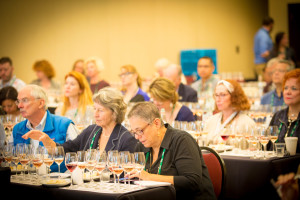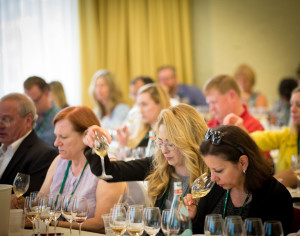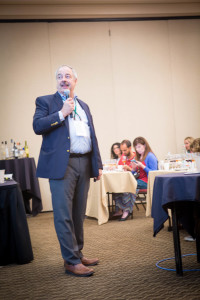We had a wonderful time at the 41st Annual Conference of the Society of Wine Educators, held August 10-12, 2016 at the lovely Red Lion Hotel on the River, located on the Columbia River in Portland, Oregon. Below you will find some pictures, presentations, and handouts provided by our wonderful speakers – the next best thing to being there!
Rosé, Brosé, Frosé!!! New to rosé? Get Familiar with some of the Basics—presented by Sharron McCarthy, CSW: On Saturday morning, Sharron McCarthy, CSW presented a session highlighting high-quality rosé wines from around the world. The session started with the facts and stats that prove that rosé is clearly positioned as a segment leader and a growing market. For instance, as concerns rosé, according to Nielsen, rosé outpaces the overall wine category for the summer of 2017, and the trend is predicted to extend well beyond the summer.
As for brosé, according to columnist Richard Whitman, “Despite rumors to the contrary, manly men drink rosé!” And who can resist frozen rosé—frosé—the hottest new drink of the season!
The discussion moved to the many ways rosé is produced, including maceration, vin gris, saignée, and blending; as well as a discussion of some of the many leading rosé-producing regions of the world. The tasting included a variety of rosé wines produced using a range of grape varieties and production methods, and included rosés from all over the world. For a list of the wines and more information, see Sharron’s presentation: Rose, Brose, Frose – presented by Sharron McCarthy, CSW
The New Wave of Boutique California Sparkling Wines—presented by David Glancy, MS: Friday afternoon, David Glancy, MS gave a fascinating session on the “new wave” of boutique sparkling wines being produced in California. The session started with a history of sparkling wine in California, which began (amazingly enough) with Agostin Haraszthy, who built California’s first ʺChampagne Cavesʺ in Sonoma County 1862, and Paul Masson, who was known as the “Champagne King of California” beginning in 1905.
The discussion then turned to the wave of French investment in California sparkling wines with such examples of Moët & Chandon (Chandon based in California), G.H. Mumm & Co (Mumm Napa), Louis Roederer (Roederer Estate), and Taittinger (Domaine Carneros). Historic California “born and bred” sparkling wine producers—still producing outstanding wines—include Schramsberg, Iron Horse, and Scharffenberger.
The tasting portion of the class included some unique wines—a sparkling Tempranillo from Capay Valley Vineyards (located in Yolo County’s Capay Valley AVA) and Flying Goat Crémant 2014 Brut (known as “Goat Bubbles) from Santa Maria Valley in San Luis Obispo County. Other outstanding wines included Riverbench Blanc de Blancs Brut (Santa Maria Valley) 2014 produced using 100% Chardonnay, and Sea Smoke Blanc de Noirs Brut (Sta. Rita Hills) 2013 produced using 100% Pinot Noir. For more details on the session and the wines, see David’s presentation: The New Wave of California Boutique Sparkling Wines – presented by David Glancy
Dessert Wines: Nectar of the Gods—presented by Ed Korry, CHE, CWE, CSS: On Saturday afternoon, Ed Korry, CHE, CWE, CSS presented a fascinating session on dessert wines. Starting with a discussion of the various production styles that produce dessert wines—including late harvest, dosage, arresting fermentation, ice wine, botrytis, and others—the session then moved on to a tasting and discussion of nine dessert wines. The first wine, Czar de José Duarte DOP Pico Vinho Licoroso 2009 Superior Meio Doce, was introduced by a discussion on the Pico DOP and the definition of vihho licoroso (as produced in the Pico DOP).
The next wine, Domaine Monemvassia PDO Malvasia Monemvassia-Malvasia 2010 (Greece) was preceded by a discussion on the history and progreny of the Malvasia grape variety. With just over 9,000 total bottles of the wine produced, this was a special tasting indeed.
The session continued on with the tasting of several Malvasia-based wines, including examples from Lipari (Italy) and Sitges (Spain). Other tastings and areas of discussion included Madeira and the sweet wines of the Roussillon. For more information, see Ed’s presentation: Nectar of the Gods-presented by Ed Korry
We will be posting many more conference recaps in the days to come, and will create a permanent record of them here.


